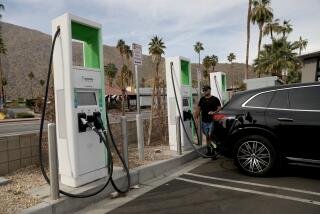GM Unveils Electric Car for Sale in California, Arizona
- Share via
It seats only two, won’t go faster than 80 mph, runs out of power after 90 miles, takes at least three hours to refuel and will set you back more than $30,000.
And unless you’re in Los Angeles, San Diego, Phoenix or Tucson, you won’t even be able to find one.
But in a splashy announcement Thursday, General Motors Corp. touted it as the wave of the future: the EV1, the first electric passenger car to be made and marketed by a major auto maker in modern times, to go on sale in 25 Saturn dealerships across the region this fall.
A converted electric Chevrolet S-series pickup truck will follow in 1997, to be marketed to commercial fleets.
“It is very tied to how we see ourselves in the future, especially our commitment to technological leadership and our commitment to environmental stewardship,” said GM Chairman John F. “Jack” Smith Jr., who made the announcement at the Greater Los Angeles Auto Show.
In an unveiling worthy of the launch of a new sports car, GM introduced the zero-emission EV1, a two-seat coupe based on its prototype electric passenger car, the Impact, which was first introduced as a concept car in 1990.
The sleek roadster, designed from the ground up as an electric vehicle, made virtually no sound as it was driven onto a rotating platform under bright lights in the Los Angeles Convention Center.
Sales of the first mass-produced electric car and truck are intended to serve as a test of the market for such vehicles as the auto industry faces state mandates to lower passenger vehicles’ emissions in order to meet air-quality standards.
GM would not discuss its projected production or sales in the four cities where the car will be introduced, saying only that it will be guided by the market.
The car will carry the General Motors badge as opposed to that of a car division--a first for the auto maker--and will be assembled at GM’s Lansing Craft Centre in Lansing, Mich. Some components will be made in California, including the vehicle’s recharging system, which will be made by GM’s Torrance-based Hughes Electronics division.
Analysts say the market for the electric car, to be priced in the mid-$30,000 range, will be limited to a few thousand at first.
California Air Resources Board Chairman John Dunlap has said auto makers have estimated they would make a total of 5,000 electric vehicles in 1996 and 1997 and 14,000 in 1998.
“Research shows that the greatest interest is among a younger audience,” said Patricia Patano, director of marketing at Agoura Hills-based J.D. Power and Associates, an automotive marketing-information and consulting firm. “But . . . a younger audience might not be able to step up to the plate cost-wise.” Other likely customers: affluent drivers looking for a second car for commuting.
Besides the hefty sticker price, there are related costs, including several hundred dollars for a recharging circuit in the driver’s residence, and a major expense to replace the batteries when they wear out in 25,000 to 50,000 miles.
On the plus side, buyers will qualify for up to $5,000 in state and federal tax breaks. In addition, the South Coast Air Quality Management District will launch a program in July to offer a $5,000 rebate to the first 1,200 Los Angeles Basin customers who buy an electric car.
The timing of the EV1 introduction comes as somewhat of a surprise because the Air Resources Board is now expected to scale back and delay its 1998 mandate for auto makers to begin selling mass-produced electric cars.
Observers have speculated that the board was considering easing the mandate in exchange for assurances from major auto makers that they would move up the introduction of some electric vehicles.
Both GM and Air Resources Board officials denied that such assurances had anything to do with the EV1 unveiling.
Other observers said the introduction of the vehicle shows that the technology is ready to go to market now.
“This gives the lie to the auto makers’ claim that the cars aren’t ready and the market isn’t there,” said Veronica Kun, senior scientist with the Natural Resources Defense Council, an environmental group. It also sets up a dangerous situation, she said, because “we can’t hang the future of the . . . air quality program on the failure or success of one manufacturer demonstrating one model.”
But Ron Roberts, an Air Resources Board member and a San Diego County supervisor, said the introduction does not change the board’s approach.
“It’s not just bringing a car to market; we want to bring a successful car with long range and adequate power, and that’s a little different question than just bringing an electric car to market,” he said. “The experience we’ll gain by their getting this on the market early is real important. . . . [But] the board is going to be flexible, while holding firm on ultimately getting the major program underway.”
The Air Resources Board has received assurances from Ford Motor Co. and Chrysler Corp. that they will begin marketing electric vehicles as early as 1997.
Technologically, the EV1 is considered the most advanced electric vehicle ever marketed, with state-of-the art aerodynamics, high energy efficiency and full safety features, including dual air bags and anti-lock brakes.
It is powered by 26 advanced lead-acid batteries with a city range of 70 miles and a highway range of 90 miles. At very low temperatures, the range drops off dramatically (around 25 miles at 20 degrees). Recharging can take up to three hours with a special plastic inductive charger, or up to 15 hours with a wall socket.
Observers who had hoped the car would contain more advanced batteries, such as a nickel-metal-hydride battery with twice the range and a much longer life span, were disappointed.
Times staff writer Marla Cone contributed to this story.






